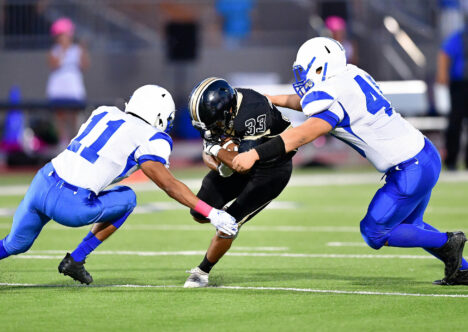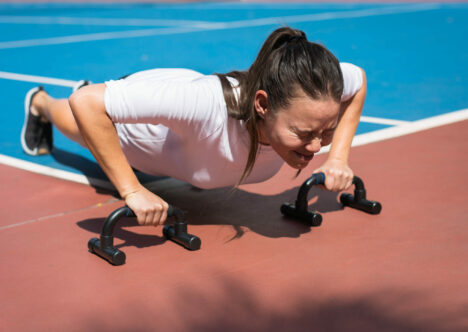Use our convenient online scheduler to book an appointment now.

The principles of golfer’s elbow treatment are simple. The great majority of cases will resolve with time. If the damaged tissue heals, you will be fine. If not, your symptoms are likely to persist. In that case, only surgical removal of the damaged and painful tissue will help. But until then, nonsurgical treatment is the mainstay.
In a previous post, I described what golfer’s elbow is, what the symptoms are and how it is diagnosed. In short, it is a painful degenerative, overuse problem affecting the tendons on the inner side of your elbow. On rare occasions, the associated inflammation and swelling can irritate a nearby nerve (ulnar nerve) and result in numbness of your ring and small finger and even more rarely, cause hand weakness. No matter the symptoms, however, the early treatment is nearly always the same – Nonsurgical.
Nonsurgical Golfer’s Elbow Treatment
For the most part, nonsurgical treatment is used to make you feel better, buy time until the tissue heals and hopefully help prevent recurrences. There is one exception to this that we will touch on later.
There are three components to the traditional nonoperative treatment:
- Prevent further injury
- Reduce pain
- Rehabilitation
Prevent Further Injury
You can’t recover if you continue to damage the injured tissue at a greater rate than at which it heals. Therefore, if you can prevent all or nearly all further injury, you have the best chance of healing. So how best to do that?
The injured tendons are responsible for gripping, pulling and palm-up lifting. So first, you must reduce or stop these activities. The key is to not cause pain. Pain is your body’s way of telling you that you are doing too much. This can be difficult. Using a wrist splint that immobilizes your wrist and therefore reduces or eliminates wrist flexion can often protect the injured tendon. A counterforce brace, like those worn for tennis elbow, can also sometimes help. For golfer’s elbow, however, the brace needs to be worn on your inner elbow, just below the bony bump.
Reduce Pain
Reducing pain is critical. It is the pain, that brings you in to see us. It’s usually, the greatest concern. Since this problem can take a long time to resolve, it is critical that your pain is reduced. Otherwise, you may not give enough time for it to heal. That can often lead to unnecessary surgery.
There are a number of things that we can do to try to reduce your pain. Avoiding painful activities is paramount. Local ice and friction massage to the area of your greatest pain is sometimes helpful. Oral anti-inflammatories and Tylenol also can sometimes help. Occasionally modalities performed in physical therapy such as electrical stimulation or ultrasound can help as well.
Additionally, the judicious use of steroid injections can often be tremendously helpful in reducing pain. This is controversial. These injections can cause damage to the tendon and on rare occasions, discoloration and thinning of the nearby skin. However, the risks of surgery are greater than that of the injection and if used sparingly, the injection isn’t likely to burn any bridges. So if the symptoms are significant, are not responding to treatment and you are considering surgery, an injection may be the safer option. It doesn’t heal the tissue and really doesn’t treat anything, but it is often a very effective way to significantly reduce or eliminate your pain. This can sometimes last months. During that time, the damaged tendon may heal and your symptoms may resolve – Permanently.
Rehabilitation
Golfer’s elbow is an overuse problem. That means that you asked your elbow to do more than it was capable of doing. There may be intrinsic factors (age, capacity to heal, etc.) that may be responsible for the injury. However, there often are some extrinsic factors that may exist as well. The extrinsic factors are often correctable. Frequent causative issues are relative weakness, muscle and/or tendon tightness, and reduced endurance.
Physical therapy, although unable to correct the intrinsic factors, can often correct the extrinsic ones. This can help prevent a recurrence once you resume your activities. As a result, physical therapy is frequently a critical component of a successful golfer’s elbow treatment program.
A Word About “Regenerative” Treatments in the ideal world, our golfer’s elbow treatment would also involve methods to stimulate healing. It turns out that such treatments may exist. There are several substances being studied and used for this purpose. PRP (Platelet Rich Plasma) and stem cells are two of the more common ones that you may hear about. Their effect is controversial and we are in our infancy of understanding them. However, there is some evidence that they may have a beneficial effect. These substances come from your own tissues. PRP comes from your blood. Stem cells may come from your blood, fat or bone marrow. Both potentially contain “growth factors” that may stimulate healing. The material is obtained with a needle or another minimally invasive technique. The substances are then administered by an injection. Unfortunately, however, these treatments are not routinely covered by most health insurance due to the controversy regarding their efficacy.
Surgical Golfer’s Elbow Treatment
Surgical treatment is reserved for those cases in which the injured tendon fails to heal, for those patients who cannot wait long enough for the problem to resolve and in those cases associated with persistent ulnar nerve symptoms whether the other symptoms resolve or not.
There are several approaches to surgery for the golfer’s elbow symptoms. The surgery can be done through a small incision. During this procedure, the damaged tissue is viewed directly and then removed. There is also a less invasive procedure. During this procedure, the damaged tendon is indirectly viewed with the aid of ultrasound. A small needle-like probe that utilizes ultrasonic vibration and suction is used to remove the damaged tissue.
Usually, the small incision approach is used If there are nerve symptoms. This allows us to address the ulnar nerve through the same incision. During this procedure, the nerve is freed or moved to an adjacent location. at the same time that the painful tendon tissue is removed.
Either way, the surgery is often followed by physical therapy. The recovery can take several months. The ultrasound-guided approach can potentially have a quicker recovery but with a potentially less predictable outcome as a tradeoff.
Golfer’s elbow treatment, fortunately, is usually nonoperative. The damaged tissue that is causing your pain usually heals. If it does, your symptoms will go away and your elbow will often feel normal. Surgery is often needed in those rare cases in which healing doesn’t occur. With it a successful outcome can be reached as well!
Join our Mailing List
TCO provides patients with orthopedic problems the trusted resources and patient-centered advice they need to “Feel Better. Move Better. Be Better.”
© 2024 Town Center Orthopaedics | All Rights Reserved


